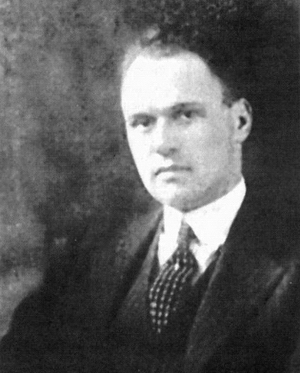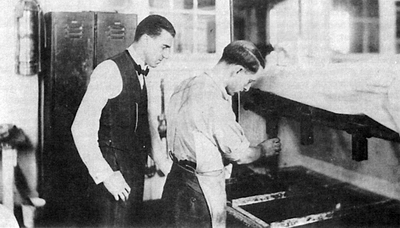|
The History of Berliner Gramophones
Part Two
by Mark Caruana-Dingli
The following part 2 of this article will focus on the contributions made by Emile Berliner, an industry pioneer who helped usher in the era of recorded sound. His move to Canada early in this industry's history is not well documented, even though his contributions continued on for many years after leaving the United States. This second part will attempt to highlight his later contributions. A subsequent third part is planned for a future issue, to catalogue the wide variety of machines produced but never fully documented. I would like to thank Oliver Berliner (Emile's Grandson and CAPS member) for his assistance with this article and for contributing information.
Berliner in Canada
Wanting to maintain a stake in
the industry and having
surrendered his rights to his
patents in other countries,
Berliner decided to move his
operations to Canada where he
had been granted patents in 1897.
This move was also necessary as,
under Canadian law, he was
required to establish production
in Canada in order to maintain
his patents. Berliner chose to
move to Montreal as he was
personal friends with many of the
officials at Bell Telephone which
was headquartered there, and
they were able to rent him
facilities. Also, having previously
sold a valuable patent to Bell, he
was able to do things with them
that would be unheard of
nowadays. This location was also
ideal as it provided easy access
by rail to Philadelphia, just
across the Delaware River from
the Victor plant in Camden, New
Jersey. Once there, he opened his
first Canadian retail store in 1899
under the name E. Berliner
Montreal, housed in the space he
rented from Bell Canada at 2315 St. Catherine
Street (improperly listed as 2315-2316 in some
sources) and later set up a factory to supply the
company nearby at 367-368 L' Aqueduc St. (now
called Lucien L'Allier St.). The first Canadian
Berliner Gram-o-phones (note the difference in
the way gramophone is written for the Canadian
Company) sold were made up from motors and
turntables imported by rail from Eldridge
Johnson and installed in cabinets manufactured at
the Montreal factory. This arrangement was
problematic for Berliner as sometimes motors
from Victor were found to be defective, with
gears that didn't mesh despite the Victor
inspectors' approval. Also, as gramophones were
a relatively unknown product, the railroads
classified them in the catchall category of
explosives, which paid the highest freight rate.
Edgar Berliner (Emile's son) eventually
persuaded the railroad to classify
gramophones as musical instruments.
Herbert and Emile Berliner, 1915

|
|
Herbert Berliner

|
|
On January 2, 1900 pressing began on 7" discs
which were pressed from matrices belonging to
affiliated Berliner Companies in the United States
and Europe. Production quickly moved from
2000 records in 1900 to an estimated 2 million in
1901, impressive first year growth by any
standard. Most early Canadian-made Berliner
records can be recognized by their brown colour
and brown paper label unlike the industry standard
of black tinted shellac used elsewhere. On July 10th
of 1900, Berliner officially registered the Nipper
logo, which would reign for a half-century as the
world's most famous trade-mark and is still the
most recognized symbol of the recording industry.
Berliner advertising from this period could also
boast that Berliner's products were a recipient of a
medal at the 1900 Canadian National Exhibition in
Toronto. As improvements in motor technology
allowed, new longer playing 10" Concert Grand
disc production was begun in 1901 with the lower
priced Black Label and higher priced Red Seal
lines, which were followed two years later by 12"
DeLuxe discs. Production of the 7 inch discs lasted
until 1909 when it became evident that the 10 and
12 inch discs were to become the industry
standard. In 1904,after several years of enviable
growth, the company was ready for some major
changes. In this year, the E. Berliner Montreal
operation was incorporated with Emile's eldest
son, Herbert Samuel Berliner, as a stockholder,
vice-president and general manager. Emile's
younger son, Edgar, an MIT graduated mechanical
engineer, would also later join the company as
secretary/treasurer. A new recording facility at
138a Peel St. in Montreal was set up and the
company quickly made arrangements to become
distributors and record pressers for Victor records
and Berliner affiliates outside Canada. With this
major coup, the Berliner Company grew
tremendously and within 2 years had to build a new
10,000 square foot, three-story factory at the corner
of St. Antoine and Lenoir streets to produce both
machines and records. Almost immediately after
beginning operations in the new facility, the
company added a five story addition to help house
their growing workforce. When completed in 1921,
the final 50,000 square foot factory was one
of the most modern buildings in Montreal and proudly
displayed a huge billboard stating "Home of the
Victrola". This success could be partially attributed
to Berliner's strict requirement that its retailers sell
Berliner products exclusively and at prices set by
Berliner, something that became a cause of friction
between the company and its dealers.
It is worth noting that Herbert Berliner's efforts to
convince Victor to produce double-sided records
were unsuccessful even though rival Columbia had
already begun their production in 1908. This seems
all the more strange when you consider that Victor
held the patents on double-sided records and had
spent the last few years in a fruitless court battle
with Columbia trying to defend these patents. It
was left to Herbert Berliner to pursue this and in
1908 Berliner released its first double-sided record
coupling a new Billy Murray release with a
previously released one. After a decade of
successes, the company reorganized in 1909 and
became the Berliner Gram-o-phone Company
Limited, with Emanuel Blount as president, Herbert
as vice-president and Edgar as secretary/treasurer.
Emile was not active in the business and instead
retired upon the royalties for the company's use of
his patents.
Herbert Berliner overseeing work at his Compo company’s pressing facility, 1921

|
|
The decade that followed saw Berliner capture and
maintain the Company's position as the leader in
Canada with Columbia a second and Edison's
prominence dropping off. Herbert also established a
subsidiary of Berliner called His Master's Voice
(HMV) which introduced a series devoted to
Canadian artists and later expanded to a series of
French-Canadian artists. Toward the end of the
teens, the patents, which had allowed Berliner,
Victor and Columbia to control the disc record
market, began to expire. In the US, this led to an
explosion of activity as many new companies began
production of records. Fearing that this could lead
to an influx of records into Canada, Herbert
decided the wisest approach to maintain some
control of the market was to establish facilities to
manufacture records in Canada for these new
companies. Thus, in 1918, H Berliners
Compo Company Limited, Canada's
first independent record
pressing facility opened in
Lachine, Quebec. With
surplus record presses
from Berliner,the
company began in
1919 to press,
label, package
and ship records
for Phonola
followed by the
Starr Company
of Canada's
Gennett label.
Herbert also began
a more aggressive
recording campaign,
which did not go
unnoticed by the Victor
Company, which began to
see a drop in their share of the
market and the resultant loss in their
royalties.
As local Canadian
recordings began
to outnumber imported Victor recordings in the
Berliner catalogue, a rift between the two
companies began to grow. As a consequence
of his disloyalty (via the establishment of Compo) Emile,
who had seized control of the company due to its
failure to pay him royalties, ousted Herbert and
named Edgar as president. Neither Emile nor Edgar
ever spoke to Herbert again; only Emile's youngest
child, Alice, ever did. After leaving the Berliner
Company, Herbert set up the Sun Record Company
sales office at 210 Adelaide Street in Toronto,
Canada to distribute his own labels, which included
the Sun and Apex brands. Edgar acquired sole
ownership of the company and Emile Berliner
retired. Victor Records then began to regain its
dominant position in the Berliner catalogue as the
HMYV series was phased out and replaced by Victor
recordings, and His Master's Voice-Canada, Ltd.,
Toronto, became Berliner's distributor.
In order to maintain this position, it was announced in 1924
that the Victor Talking Machine Company
was acquiring ownership of the
Berliner Gram-o-phone
Company and its subsidiary
His Master's Voice by
exchanging with Emile
Berliner Gram-o-phone
shares for Victor's.
With this purchase,
and a name change
to the Victor Talking
Machine Company
of Canada Ltd.,
Canada's first
talking machine
company ceased to
exist in name even
though Edgar Berliner
(still a stockholder) was
kept on as president.
This year was to be a particularly
bad one for Herbert's Compo
Company which suffered a $35,000
setback when, in November,the storage
warehouse in Lachine went up in flames. Over the
next few years, the Victor Company's decision to
put pressure on Herbert to resign from the Berliner
Company would come back to haunt them as
Compo's share of the market increased. As Compo
continually undercut Victor's record prices, a series
of dealer revolts resulted in Victor having to reduce
their prices. As a final blow to Victor, Herbert put
his support behind the Starr Piano Company in a
1921 legal case over Victor patents on lateral cut
records. Herbert's decision to turn against his
former partner resulted in the court's setting aside
the valuable Victor patents.
As the decade drew to a close, Emile Berliner, the
father of the disc gramophone died of a heart attack
at the age of 78 on August 3, 1929 in Montreal,
Canada. It is a tribute to his genius and drive that
three of the top record companies began from
Berliner's companies; RCA descending from
Berliner to Victor, EMI from his British company
and Polygram from his German Deutsche
Grammophone.
In the same year that Berliner died, the Radio
Corporation of America (RCA) merged with Victor
in the US and Canada to form RCA Victor
(renamed BMG music in 1987). The next year, as a
result of pressure from the RCA Victor Company in
the United States, Edgar Berliner resigned as
president in 1930. This ended the Berliner family
involvement in the original company and left only
one family member remaining in the record
business. The last of the Berliner family to remain
in the business, Herbert Berliner, remained with his
Compo Company, becoming one of the few to
survive the depression. By the mid 30s, a new
entrant, Decca Records, had begun eating into the
profitable American market. Herbert again seeing
an opportunity made a deal with Decca to begin in
1935 pressing and distributing their records. In
1955, having moved to California, Edgar Berliner
died at the age of 69. This same year Edgar's son
Oliver began producing records for his own label
and others, while at the same time opening a music
publishing business that continues to this day in
California.
In 1966 Herbert Berliner (b 1882) having survived
the early pioneering days, the depression, the
introduction of the LP record and the 45 rpm 7"
disc died in Montreal. The Compo Company was
then sold to Decca Records in 1950 marking the
end of the Berliner family involvement in the
Canadian talking machine industry.
15 years later, MCA purchased Decca and sadly, in
the early 70s, the doors closed on Canada's second-
earliest record pressing facility which had been in
Lachine, Quebec since 1918.
|